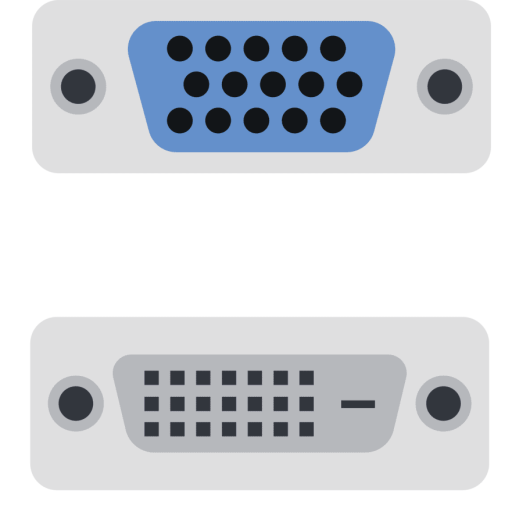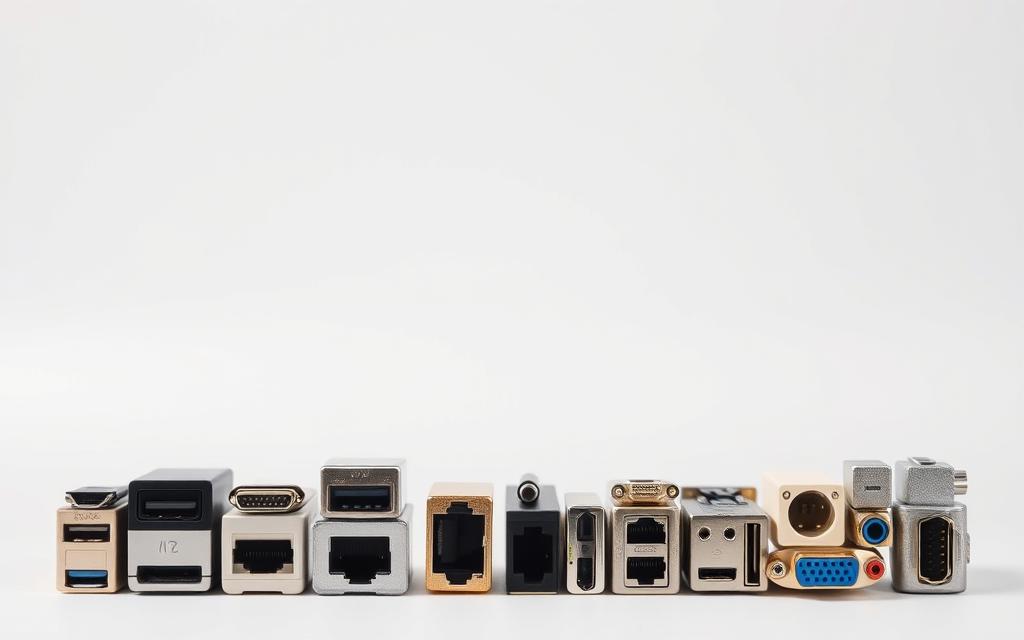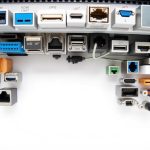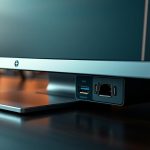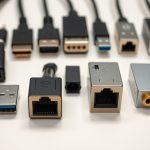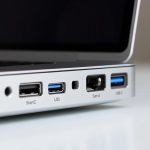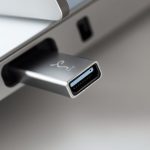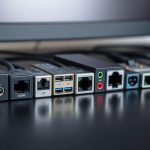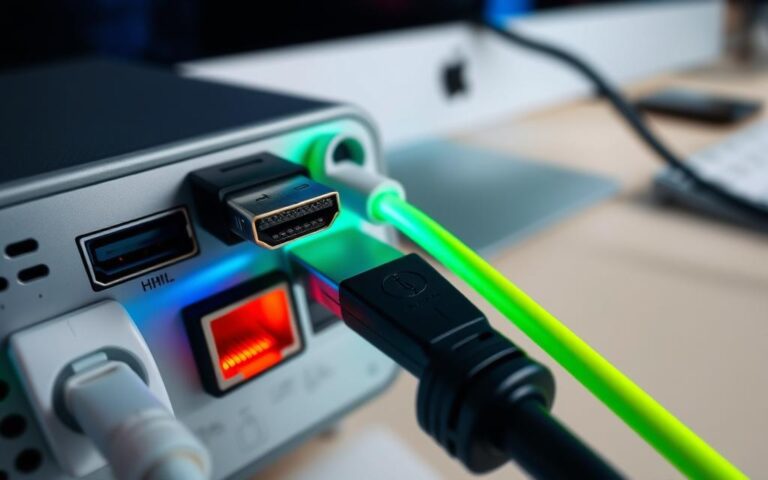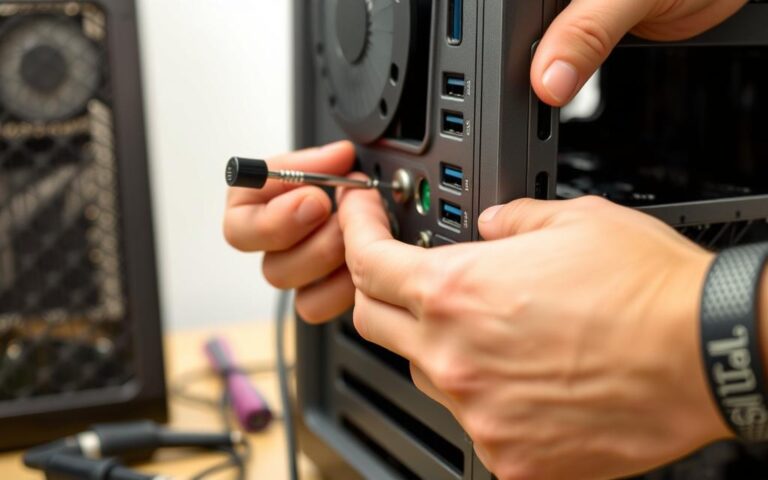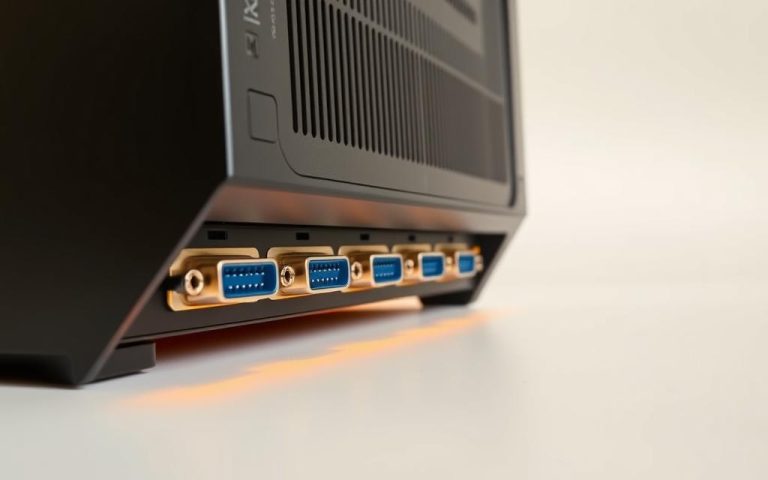Every Port on a PC Explained: What They Do and Why
A computer port is a vital component that enables connection between a computer and external devices, facilitating data transfer and output. Essentially, it’s the interface between an external device and the PC’s motherboard.
Understanding the various ports on your computer can help maximise its functionality and avoid compatibility issues when connecting peripherals. This comprehensive guide will explore the essential ports found on modern and legacy PCs, explaining their functions and practical applications.
From common USB and HDMI ports to specialised connections like Thunderbolt, knowing what each port does will help you make informed decisions when purchasing accessories or troubleshooting connection problems.
Understanding PC Ports and Their Importance
The ports on a computer serve as the primary interface between the device and external peripherals, highlighting their significance. In essence, computer ports are the physical interfaces that allow your PC to communicate with external devices.
What Is a Computer Port?
A computer port is a connection point on a computer that allows users to connect external devices, such as keyboards, mice, printers, and storage devices. These ports enable data transfer, power delivery, and signal transmission between the computer and the connected device. In simple terms, a computer port is a gateway that facilitates communication between the computer and external peripherals.
How Ports Have Evolved Over Time
Over the years, computer ports have undergone significant transformations to keep pace with technological advancements. From the early serial and parallel ports to the modern high-speed digital interfaces like USB-C and Thunderbolt, ports have evolved to meet the changing needs of computer users. The evolution of ports reflects the shift from simple data transfer to high-definition video output, fast charging, and simultaneous multi-device connectivity.
| Port Type | Functionality | Common Use |
|---|---|---|
| USB | Data transfer, power delivery | Connecting peripherals, charging devices |
| HDMI | High-definition video output | Connecting to monitors or TVs |
| Ethernet | Wired internet connection | Connecting to a network |
Understanding the different types of computer ports and their functions is essential for maximising your computer’s functionality and ensuring compatibility with peripherals and accessories.
USB Ports: The Universal Connection
The Universal Serial Bus, or USB, has revolutionised the way we connect devices to our computers. With its versatility and widespread adoption, USB has become the go-to interface for transferring data between devices.
USB Type-A: The Classic Standard
USB Type-A is the most common USB port, found on almost every laptop or PC. Its distinctive rectangular shape has made it a familiar sight, and it remains widely used despite the emergence of newer variants. USB Type-A ports are often used for connecting peripherals such as flash drives, keyboards, and mice.
USB Type-B and Mini/Micro Variants
Beyond Type-A, the USB connector landscape includes various form factors, such as Type-B, commonly used for printers and scanners, and the smaller Mini and Micro variants found on older portable devices. These variants have played a crucial role in expanding the range of devices that can be connected via USB.
USB Type-C: The Modern All-in-One
USB Type-C represents the future of connectivity, with its reversible design, higher power delivery capabilities, and support for multiple protocols, including video output and faster data transfer. This modern connector is becoming increasingly popular, particularly among newer devices such as smartphones and laptops.
USB Speed Standards: 2.0, 3.0, and Beyond
Understanding USB speed standards is crucial for maximising performance. The various standards, from USB 2.0 (480 Mbps) to USB 3.0/3.1 Gen 1 (5 Gbps), USB 3.1 Gen 2 (10 Gbps), and the latest USB 4.0 (up to 40 Gbps), offer significantly different data transfer rates. When purchasing USB devices or cables, it’s essential to match the speed standard to your needs, as faster standards are backward compatible but will only operate at the speed of the slowest component in the chain.
In conclusion, USB ports have transformed computer connectivity, offering a versatile and widely-used interface for a range of devices. By understanding the different types of USB ports and their capabilities, users can make informed decisions when selecting devices and cables.
Video Output Ports on a PC
When connecting your PC to external displays or monitors, the type of video output port you use can significantly impact your viewing experience. Video output ports are essential for connecting your PC to external displays, monitors, projectors, and televisions, with different standards offering varying levels of quality and functionality.
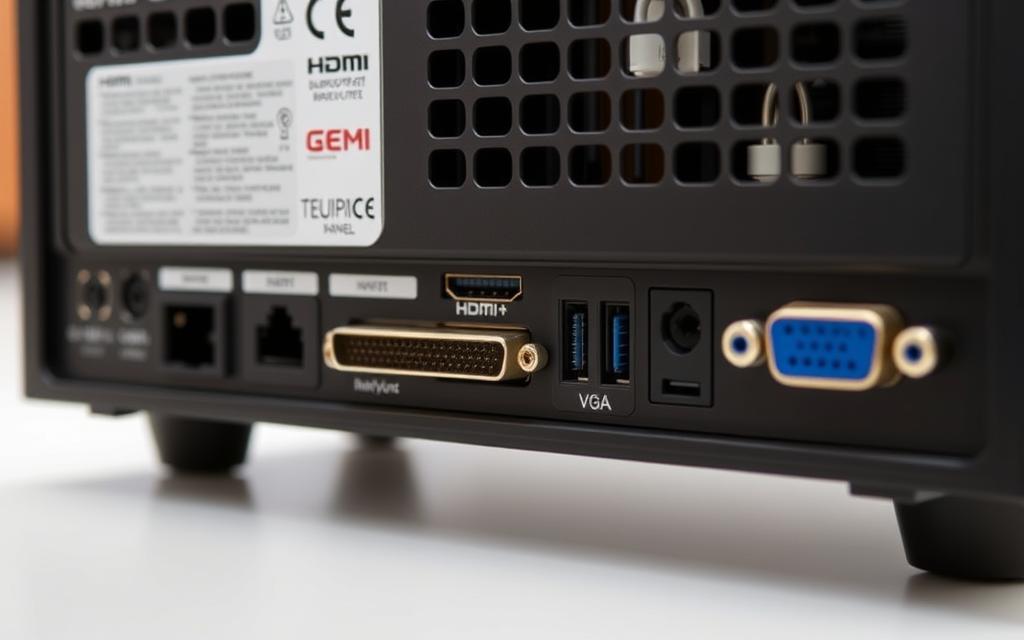
HDMI: High-Definition Multimedia Interface
HDMI has become the most ubiquitous video connection standard, capable of transmitting both high-quality video and audio through a single cable to compatible displays. Modern HDMI ports support resolutions up to 4K (and beyond with HDMI 2.1), making them ideal for high-definition gaming, video editing, and media consumption across multiple monitors.
DisplayPort: The Professional Choice
DisplayPort offers several advantages over HDMI for professional applications, including higher bandwidth, the ability to daisy-chain multiple monitors, and better support for higher refresh rates valued by gamers and creative professionals. It is developed by the Video Electronics Standards Association (VESA) as a high-performance replacement for other prominent display options.
VGA and DVI: Legacy Video Connections
Despite being largely superseded by newer standards, legacy video connections like VGA (Video Graphics Array) and DVI (Digital Visual Interface) may still be found on older monitors and projectors. For a comprehensive list of video connectors, you can refer to the Wikipedia page on video connectors, which provides detailed information on various types of video ports.
Understanding the capabilities of each video port type is crucial when setting up multi-monitor workstations or connecting to presentation equipment in different environments. Many modern laptops with limited port options can still connect to various display types through USB-C ports that support DisplayPort Alt Mode or through appropriate adapters.
Audio Ports and Connections
Audio ports play a vital role in enabling sound input and output on computers. The variety of audio ports available on modern devices allows users to connect a range of audio hardware, from simple headphones to complex sound systems.
3.5mm Audio Jack: Headphones and Microphones
The 3.5mm audio jack remains the most common and recognisable audio port, used for both headphones and microphones. Most computers feature separate ports for headphone output and microphone input, often colour-coded for easy identification. Modern motherboards typically follow a standardised colour scheme: green for line-out/headphones, blue for line-in, and pink for microphone input.
S/PDIF and Other Digital Audio Connections
Beyond the basic 3.5mm connections, many higher-end computers include digital audio options like S/PDIF (connector), which provides superior audio quality through optical or coaxial connections. Digital audio connections bypass the computer’s internal digital-to-analog conversion process, resulting in cleaner audio signals that are less susceptible to electrical interference. This is particularly beneficial for users requiring high-quality sound for professional applications or gaming.
For users with specific audio needs, such as content creators working with multi-channel sound, understanding the audio port capabilities of their computer is crucial. Some devices offer specialised audio ports or support for external audio interfaces that connect via USB or Thunderbolt, enhancing their functionality and flexibility.
Network and Internet Connectivity Ports
In the realm of computer hardware, network and internet connectivity ports are essential for facilitating communication between devices. These ports enable computers to connect to the internet, local area networks (LANs), and wide area networks (WANs), thereby providing the necessary infrastructure for data exchange and communication.
Ethernet (RJ-45): Wired Internet Connection
The Ethernet port, also known as the RJ-45 port, is a staple for establishing wired internet connections. It connects a computer to a router or modem using an ethernet cable, facilitating high-speed data transfer. Ethernet ports are commonly found on desktop computers and are valued for their reliability, speed, and security. They offer speeds ranging from 100 Mbps to 1 Gbps, with newer systems capable of reaching up to 10 Gbps.
RJ-11: The Telephone Connection
The RJ-11 port, while less common on modern computers, is used for connecting to telephone lines. Historically, it was used for dial-up internet connections and fax capabilities. Some business-oriented computers still include RJ-11 ports for compatibility with certain networking equipment or landline telephone connections.
Network connectivity ports are crucial for establishing internet and local network connections. The choice between wired and wireless connections depends on the specific needs of the user, with ethernet connections offering advantages such as lower latency and better security.
| Port Type | Common Use | Speed |
|---|---|---|
| Ethernet (RJ-45) | Wired internet connection | 100 Mbps to 10 Gbps |
| RJ-11 | Telephone and dial-up internet | Up to 56 kbps |
Understanding the capabilities and limitations of your computer’s network ports is essential for setting up efficient home or office networks. Whether you require the high-speed, low-latency connection of an ethernet port or the specific functionality of an RJ-11 port, knowing your options is key to making informed decisions about your network infrastructure.
Storage and Memory Card Ports
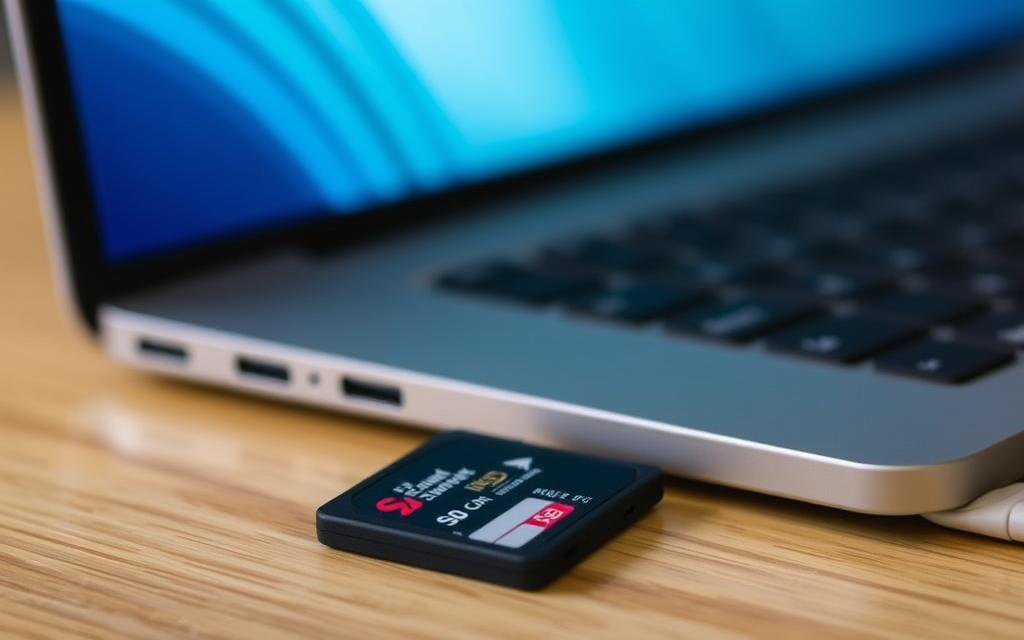
Storage and memory card ports on a PC are essential for users who need to transfer data from devices like cameras and smartphones. These ports provide the necessary connectivity for expanding storage capacity and transferring files between devices.
SD Card Readers: Full-Size, Mini, and Micro
SD card readers are a common feature on many laptops and desktops, allowing users to access memory cards used in various portable devices. Modern computers often support multiple SD card formats, including full-size SD, miniSD, and microSD, sometimes requiring adapters for the latter two. This versatility makes it easy to transfer photos, videos, and other files directly from capture devices.
The presence of a built-in SD card reader is particularly valuable for professionals like photographers and videographers who frequently need to transfer large media files. For instance, a photographer can directly insert their camera’s SD card into the laptop’s card reader, facilitating quick data transfer without the need for additional cables or adapters.
External Storage Connection Options
Beyond memory card slots, computers offer various connection options for external storage devices. USB ports are commonly used for connecting flash drives and external hard drives, providing an easy way to expand a computer’s storage capacity without having to open the case or replace internal components.
For users with limited internal storage, these external storage connections are invaluable. They allow for the supplementation of storage needs, making it possible to store less frequently used files on external devices, thus keeping the internal storage free for more critical applications.
Thunderbolt Ports: The Speed Champions
With their unparalleled speed, Thunderbolt ports are redefining the future of data transfer. These ports represent the pinnacle of connection technology, offering unprecedented speeds and versatility that far exceed traditional port capabilities.
Developed through a collaboration between Intel and Apple, Thunderbolt technology combines PCI Express and DisplayPort into a single serial data interface, enabling exceptional data transfer rates. The latest Thunderbolt 3 and 4 ports deliver blazing-fast 40 Gbps data transfer speeds, making them ideal for professionals working with large files or requiring multiple high-resolution displays.
Thunderbolt 3 and 4: Features and Capabilities
Thunderbolt 3, which uses the USB-C connector, is eight times faster than USB 3.0 and four times more video bandwidth than HDMI. It can transfer an entire 4K resolution film in less than 30 seconds and power two 4K monitors simultaneously. Thunderbolt 4 maintains the same 40 Gbps speed but adds mandatory support for dual 4K displays, PCIe at 32 Gbps, and improved security features.
| Feature | Thunderbolt 3 | Thunderbolt 4 |
|---|---|---|
| Data Transfer Speed | Up to 40 Gbps | Up to 40 Gbps |
| Display Support | Dual 4K Displays | Dual 4K Displays |
| Power Delivery | Up to 100W | Up to 100W |
Compatibility with Other Port Types
While Thunderbolt ports use the same physical connector as USB-C, not all USB-C ports support Thunderbolt. Devices with Thunderbolt capability are typically marked with a lightning bolt symbol. Thunderbolt ports are versatile, making them ideal for connecting external graphics cards, high-speed storage arrays, and docking stations that expand connectivity options.
The versatility and speed of Thunderbolt ports make them a valuable asset for professionals and gamers alike, significantly improving workflow efficiency and reducing cable clutter.
Legacy Ports You Might Still Encounter
The evolution of computer ports has led to the emergence of legacy ports, which, although less common, still serve important purposes in certain contexts. These older connection standards, while largely superseded by modern alternatives, continue to be relevant in specific industries and applications.
Serial and Parallel Ports
Serial ports, also known as COM or RS-232 ports, were once the standard for connecting modems, mice, and other peripherals. They transmit data one bit at a time through a 9-pin or 25-pin connector. Parallel ports, recognisable by their 25-pin connectors, were primarily used for connecting printers and scanners, offering faster data transfer than serial ports by sending multiple bits simultaneously.
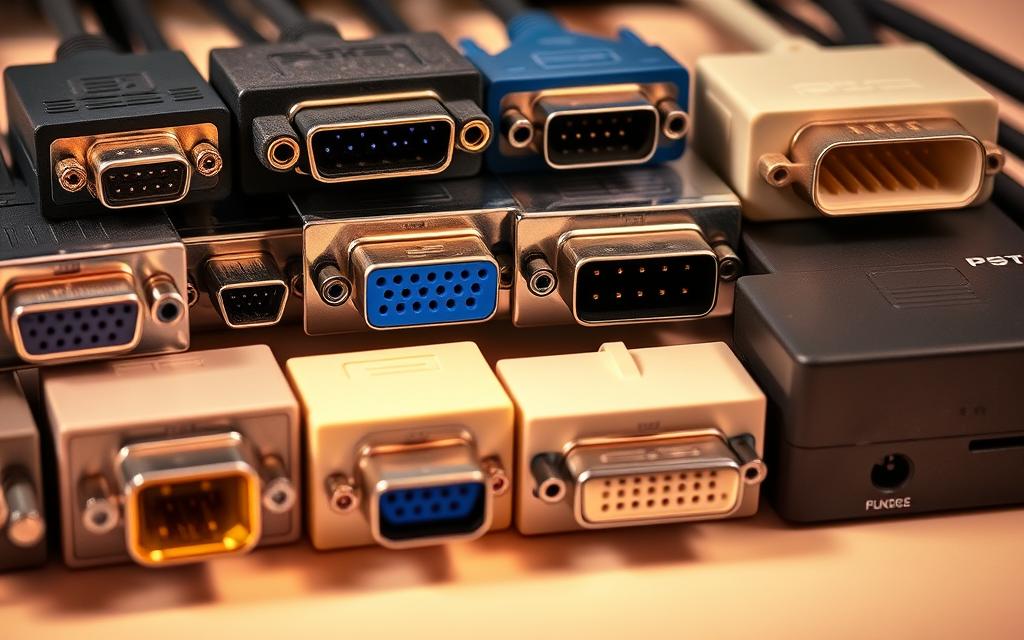
PS/2 Ports for Keyboard and Mouse
PS/2 ports, with their distinctive round shape and colour coding (purple for keyboards, green for mice), were the standard for input device connections before USB became widespread. Some modern motherboards still include PS/2 ports for compatibility with older peripherals and for scenarios where instantaneous recognition is beneficial.
FireWire: The Former Speed King
FireWire (IEEE1394) was once the preferred high-speed connection for digital video cameras and external hard drives, offering speeds of up to 800 Mbps that outpaced early USB standards. Although largely superseded by newer technologies, FireWire remains important in certain industries.
Legacy ports represent older connection standards that, while less common on modern computers, may still be encountered on older systems or specialised equipment. Understanding these legacy connections can be valuable when working with older equipment or in environments where equipment replacement cycles are longer.
- Legacy ports, such as serial, parallel, PS/2, and FireWire, continue to be used in specific contexts.
- These ports were once standard but have been largely superseded by newer technologies like USB.
- Certain industries and applications still rely on these older connection standards.
Specialised Ports for Specific Uses
Specialised ports on computers serve unique purposes, often related to professional or industry-specific requirements. These ports are designed to meet the needs of specific industries or applications, providing functionality that goes beyond standard connectivity options.
Some of the specialised ports include eSATA (External Serial Advanced Technology Attachment) ports, which were developed for external storage devices. eSATA offers significantly faster data transfer rates compared to USB 2.0 for hard drives, without the overhead of protocol conversion.
eSATA: External SATA Connections
eSATA connections provide a high-speed interface for external storage devices, making them ideal for applications where fast data transfer is critical. Although largely superseded by USB 3.0 and Thunderbolt, eSATA may still be found on older workstations and servers.
Game Ports and Other Niche Connections
Game ports, recognisable by their 15-pin D-sub connectors, were once standard on sound cards for connecting joysticks and other game controllers. However, they have been largely replaced by USB connections. Other niche connections include SDI (Serial Digital Interface) for broadcast video equipment and MIDI ports for professional audio hardware.
- eSATA ports offer faster data transfer rates for external storage devices.
- Game ports were used for connecting game controllers before being replaced by USB.
- SDI and MIDI ports cater to specific professional needs in video and audio industries.
Understanding these specialised ports is crucial in professional environments where legacy equipment or industry-specific hardware may still rely on these connection standards.
Port Expansion Solutions
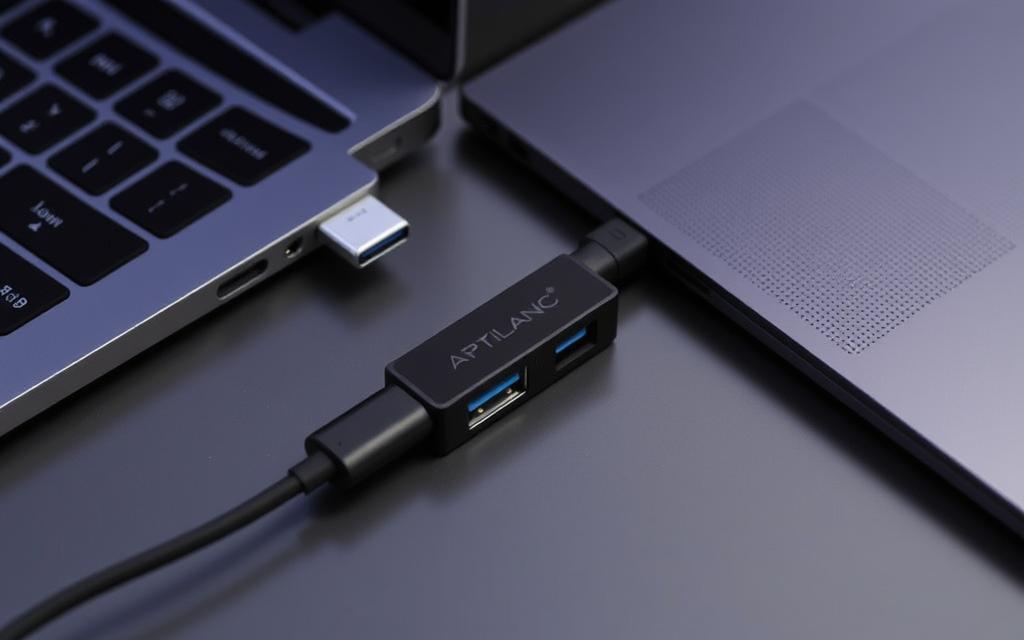
As laptops become increasingly slim and feature-limited ports, the need for port expansion solutions has become more pressing. Users require ways to connect multiple devices to their laptop, including keyboards, mice, flash drives, and other peripherals.
USB Hubs and Docking Stations
USB hubs provide a simple form of port expansion, allowing multiple USB devices to connect through a single USB port on your computer. This is ideal for connecting several peripherals simultaneously. Powered USB hubs offer additional benefits by providing external power to connected devices, ensuring stable connections for peripherals that require more power than a standard USB port can deliver.
Adapters and Converters for Port Compatibility
For ultraportable laptops with only USB-C ports, multiport adapters can restore essential connectivity options like HDMI, USB-A, and ethernet through a compact, portable solution. Dedicated adapters and converters can bridge compatibility gaps between different port standards, such as HDMI to DisplayPort or USB-C to VGA for connecting to older projection systems.
When choosing expansion solutions, it’s essential to consider the bandwidth limitations to avoid performance bottlenecks. Thunderbolt docks offer the highest performance for expansion, supporting multiple 4K displays, high-speed data transfers, and power delivery through a single cable connection to compatible laptops.
How to Choose a PC Based on Port Selection
A well-informed decision when purchasing a PC hinges on understanding the different ports and their uses. With various types of computer ports available, selecting a device that meets your specific needs is crucial.
Assessing Your Connectivity Needs
Begin by evaluating your current peripheral ecosystem. Consider whether you have legacy devices requiring specific ports or if you’re willing to use adapters for compatibility. Different user profiles have distinct connectivity requirements; for instance, creative professionals may prioritise Thunderbolt ports for external drives and displays, while business users might need ethernet ports for reliable network connections.
- Assess your typical workflow and environment.
- Consider the physical placement of ports on laptops to avoid interference.
- Ensure your chosen computer has appropriate video outputs if you frequently connect to external displays.
Future-Proofing Your Port Options
For future-proofing, prioritise computers with USB-C/Thunderbolt ports, which offer the greatest versatility and are becoming the standard for most new peripherals and accessories. Be cautious of ultraportable laptops that sacrifice essential ports for thinness, as the cost of required dongles and adapters can quickly add up.
Conclusion
Having explored the various ports on a PC, it’s evident that each serves a unique purpose in enhancing our computer’s capabilities. Understanding these ports is crucial for maximising functionality and ensuring seamless connectivity with peripheral devices.
From versatile USB options to specialised video, audio, and network connections, the right port configuration can significantly enhance productivity and reduce the need for unnecessary adapters. As technology advances, standards like USB-C and Thunderbolt continue to emerge, offering faster speeds and greater versatility.
When selecting a PC, it’s essential to consider current and future connectivity needs. By doing so, users can make informed decisions about their technology ecosystem, ultimately streamlining their workflow and improving overall computing experiences.
FAQ
What is the difference between USB 2.0 and USB 3.0?
USB 3.0 offers significantly faster data transfer speeds of up to 5 Gbps, whereas USB 2.0 has a maximum speed of 480 Mbps. This makes USB 3.0 more suitable for transferring large files and connecting high-speed devices.
Can I use an HDMI cable for audio-only connections?
Yes, HDMI cables can be used for audio-only connections, but they are typically used for both audio and video. HDMI supports high-definition audio formats, making it a versatile option for home entertainment systems.
What is the purpose of an SD card reader?
An SD card reader allows users to transfer data from an SD card to a computer. It is commonly used in laptops and desktops to expand storage capacity and facilitate data exchange between devices.
How do I know if my laptop supports USB Type-C?
Check your laptop’s specifications or manufacturer’s documentation to confirm if it has a USB Type-C connector. You can also inspect the USB ports on your laptop to identify the Type-C connector, which is reversible and typically marked with a “C” logo.
What is the difference between DisplayPort and HDMI?
DisplayPort and HDMI are both digital video interfaces, but they have different capabilities and are used in different contexts. DisplayPort is often used in professional settings due to its ability to support multiple monitors and higher video resolutions.
Can I use a USB hub to expand my computer’s USB ports?
Yes, a USB hub can be used to expand the number of available USB ports on your computer. Simply connect the hub to your computer, and you can then connect multiple devices to the hub.
What is Thunderbolt 3, and how does it differ from USB Type-C?
Thunderbolt 3 is a high-speed interface that uses the USB Type-C connector. While USB Type-C is a standard for USB connections, Thunderbolt 3 offers faster speeds of up to 40 Gbps and supports more advanced features like multiple 4K displays.
How do I choose the right external hard drive for my needs?
When selecting an external hard drive, consider factors like storage capacity, data transfer speed, and compatibility with your computer. Look for a drive that matches your needs and is compatible with your computer’s USB ports or other connection options.
